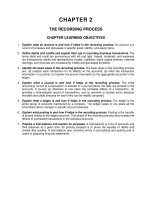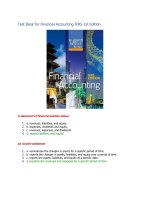Financial accounting IFRS 4 kieoso ch10 PPT
Bạn đang xem bản rút gọn của tài liệu. Xem và tải ngay bản đầy đủ của tài liệu tại đây (137.44 KB, 47 trang )
Financial Accounting
IFRS 4th Edition
Weygandt ● Kimmel ● Kieso
Chapter 10
Current Liabilities
Chapter Outline
Learning Objectives
LO 1 Explain how to account for current liabilities.
LO 2 Discuss how current liabilities are reported and
analyzed.
Copyright ©2019 John Wiley & Sons, Inc.
2
Learning Objective 1
Explain How to Account for Current
Liabilities
Copyright ©2019 John Wiley & Sons, Inc.
3
Accounting for Current Liabilities
What is a Current Liability?
A debt that a
company expects to pay within one year or
the operating cycle, whichever is longer.
Current liabilities include notes payable, accounts
payable, unearned revenues, and accrued liabilities
such as taxes payable, salaries and wages payable,
and interest payable.
Copyright ©2019 John Wiley & Son, Inc.
4
What Is a Current Liability? (1 of 2)
Review Question
To be classified as a current liability, a debt must be
expected to be paid within:
a. 1 year.
b. the operating cycle.
c. 2 years.
d. (a) or (b), whichever is longer.
Copyright ©2019 John Wiley & Sons, Inc.
5
What Is a Current Liability? (2 of 2)
Review Question
To be classified as a current liability, a debt must be
expected to be paid within:
a. 1 year.
b. the operating cycle.
c. 2 years.
d. (a) or (b), whichever is longer.
Copyright ©2019 John Wiley & Sons, Inc.
6
Notes Payable (1 of 4)
• Written promissory note
• Usually requires borrower to pay interest
• Frequently issued to meet short-term financing needs
• Issued for varying periods of time
• Usually classified as current liability if due for
payment within one year of statement of financial
position date
Copyright ©2019 John Wiley & Sons, Inc.
7
Notes Payable (2 of 4)
Illustration: First Hunan Bank agrees to lend ¥100,000 on
September 1, 2020, if Yang Enterprises signs a ¥100,000, 12%,
four-month note maturing on January 1 (amounts in
thousands). When a company issues an interest-bearing note,
the amount of assets it receives upon issuance of the note
generally equals the note’s face value. Yang therefore will
receive ¥100,000 cash and will make the following journal
entry.
Sept. 1
Cash
Notes Payable
100,000
Copyright ©2019 John Wiley & Sons, Inc.
100,000
8
Notes Payable (3 of 4)
Illustration: If Yang prepares financial statements annually, it
makes an adjusting entry at December 31 to recognize
interest expense and interest payable. Compute the interest
for the four months ended December 31, 2020.
¥100,000 x 12% x 4/12 = ¥4,000
Yang makes an adjusting entry as follows.
Dec. 31
Interest Expense
Interest Payable
Copyright ©2019 John Wiley & Sons, Inc.
4,000
4,000
9
Notes Payable (4 of 4)
Illustration: At maturity (January 1, 2021), Yang must pay the
face value of the note plus interest. It records payment of the
note and accrued interest as follows.
Jan. 1
Notes Payable
Interest Payable
Cash
100,000
4,000
Copyright ©2019 John Wiley & Sons, Inc.
104,000
10
Value-Added Taxes Payable (1 of 2)
• A consumption tax
• Tax is placed on a product or service whenever value
is added at a stage of production and at final sale
• Cost to end user, normally a private individual, similar
to a sales tax
• Tax is collected every time a business purchases
products from another business in the product’s
supply chain
Copyright ©2019 John Wiley & Sons, Inc.
11
Value-Added Taxes Payable (2 of 2)
Illustration: Hill Farms Wheat grows wheat and sells it to
Sunshine Baking for €1,000. Hill Farms Wheat makes the
following entry to record the sale, assuming the VAT is 10%.
Cash
Sales Revenue
Value-Added Taxes Payable
Copyright ©2019 John Wiley & Sons, Inc.
1,100
1,000
100
12
Sales Taxes Payable (1 of 3)
• Sales taxes are expressed as a stated percentage of
the sales price
• Selling company
collects tax from customer
remits collections to taxing authority
Copyright ©2019 John Wiley & Sons, Inc.
13
Sales Taxes Payable (2 of 3)
Illustration: Cooley Grocery sells loaves of bread totaling
€800 on a given day. Assuming a sales tax rate of 6%, Cooley
make the following entry record the sale.
Cash
Sales Revenue
Sales Taxes Payable
848
Copyright ©2019 John Wiley & Sons, Inc.
800
48
14
Sales Taxes Payable (3 of 3)
Sometimes companies do not enter sales taxes separately in
the cash register. If Cooley Grocery enters total receipts of
€10,600. Because the amount received from the sale is equal
to the sales price 100% plus 6% of sales, we compute the
sales amount as follows:
€10,600 ÷ 1.06 = €10,000
The journal entry is:
Cash
Sales Revenue
Sales Taxes Payable
10,600
Copyright ©2019 John Wiley & Sons, Inc.
10,000
600
15
Unearned Revenues (1 of 2)
Revenues received before the company
delivers goods or
provides services.
Type of Business
Airline
Magazine publisher
Hotel
Account Title
Unearned Revenue
Revenue
Unearned Ticket Revenue
Ticket Revenue
Unearned Subscription Revenue Subscription Revenue
Unearned Rent Revenue
Rent Revenue
Copyright ©2019 John Wiley & Son, Inc.
16
Unearned Revenues (2 of 2)
Illustration: Liverpool F.C. (GBR) sells 10,000 season soccer
(football) tickets at £50 each for its five-game home schedule.
The entry for the sale of season tickets is:
Aug. 6
Cash (10,000 x £50)
Unearned Ticket Revenue
500,000
500,000
As each game is completed, Liverpool records the recognition
of revenue with the following entry.
Sept. 7 Unearned Ticket Revenue
100,000
Ticket Revenue (Ê500,000 ữ 5)
100,000
Copyright â2019 John Wiley & Sons, Inc.
17
Salaries and Wages (1 of 4)
Companies report as a current liability the amounts owed
to employees for salaries or wages at the end of an
accounting period.
In addition, they often also report as current liabilities the
following items.
1. Payroll deductions.
2. Bonuses.
Copyright ©2019 John Wiley & Sons, Inc.
18
Payroll Deduction (1 of 4)
Most common types of payroll deductions: taxes,
insurance premiums, employee savings, union dues.
Social Security Taxes
• Social benefits (for retirement, unemployment,
income, disability, and medical benefits) to
individuals and families
• Funds generally come from taxes levied on both the
employer and the employee
Copyright ©2019 John Wiley & Son, Inc.
19
Payroll Deduction (2 of 4)
Most common types of payroll deductions: taxes,
insurance premiums, employee savings, union dues.
Income Tax Withholding
• Income tax laws generally require employers to
withhold from each employee’s pay the applicable
income tax due on those wages
• Employer computes the amount of income tax to
withhold according to a government-prescribed
formula or withholding tax table
Copyright ©2019 John Wiley & Son, Inc.
20
Payroll Deduction (3 of 4)
Illustration: Assume Cumberland Company records its payroll
for the week of January 14 as follows:
Jan. 14 Salaries and Wages Expense
Income Taxes Payable
Social Security Taxes Payable
Union Dues Payable
Salaries and Wages Payable
10,000
1,320
800
88
7,792
Record the payment of this payroll on January 14.
Jan. 14 Salaries and Wages Payable
Cash
Copyright ©2019 John Wiley & Sons, Inc.
7,792
7,792
21
Payroll Deduction (4 of 4)
Illustration: As the employer, Cumberland is also required to
pay Social Security taxes and often other taxes as well
(referred to as employer payroll taxes). It records payroll taxes
related to the January 14 payroll as follows.
Jan. 14 Payroll Tax Expense
Social Security Taxes Payable
Copyright ©2019 John Wiley & Sons, Inc.
800
800
22
Profit-Sharing and Bonus Plans (4 of 4)
Many companies give a bonus to certain or all employees in
addition to their regular salaries or wages.
Illustration: Palmer Group will pay out bonuses of NT$10,700
in January 2021. Palmer makes an entry dated December 31,
2020, to record the bonuses as follows.
Salaries and Wages Expense
Salaries and Wages Payable
10,700
10,700
In January 2021, Palmer pays the bonus.
Salaries and Wages Payable
Cash
Copyright ©2019 John Wiley & Sons, Inc.
10,700
10,700
23
Current Maturities of Long-Term Debt
• Portion of long-term debt that comes due in current year
• No adjusting entry required
Illustration: Wendy Construction issues a five-year, interestbearing €25,000 note on January 1, 2020. This note specifies
that each January 1, starting January 1, 2021, Wendy should pay
€5,000 of the note. When the company prepares financial
statements on December 31, 2020, what amount should be
reported as a
1. Current liability?
2. Long-term liability?
€5,000
€20,000
Copyright ©2019 John Wiley & Sons, Inc.
24
Do It! 1: Current Liabilities (1 of 4)
You and several classmates are studying for the next
accounting examination. They ask you to answer the following
questions.
1. If cash is borrowed on a HK$50,000, 6-month, 12% note on
September 1, how much interest expense would be
incurred by December 31?
HK$50,000 x 12% x 4/12 = HK$2,000
Copyright ©2019 John Wiley & Sons, Inc.
25









